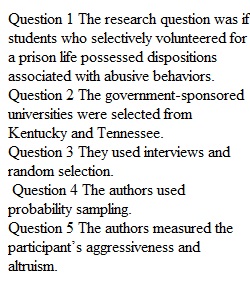


Q (This exercise is based on Chapter 8, with some excursions to the previous course material, so make sure to read the chapter before starting the exercise!) Directions: Read the article by Carnahan and McFarland (2007) and answer the following questions. Carnahan, T., & McFarland, S. (2007). Revisiting the Stanford Prison Experiment: Could participant self-selection have led to the cruelty? Personality and Social Psychology Bulletin, 33(5), 603-614. (Full text attached below) 1. What is the main research question investigated in the study? Hint: you can probably infer it from the abstract. 2. Where did the study try to recruit participants? Hint: see p. 607 of the article. 3. What were the two different ways the study authors have used for recruiting? Hint: see p. 607 of the article. 4. What type of sampling would you say this is? Hint: was there a random selection from a list (sampling frame) representing the population of interest? If yes, it's probability sampling. If not, it's non-probability sampling. To answer this question, identify the specific type within the probability or non-probability sampling. 5. Which psychological characteristics of the participants have the authors measured (that were not measured in SPE)? Hint: see p. 606 of the article. 6. Choose one of these psychological characteristics and describe how it was measured. Does the description of the measure in the article seem reasonable to you? Explain. Hint: descriptions of traits being measured are on p. 606 but the description of the actual way they were measured are on pp. 607-608, at the end of the Method section. 7. Which three psychological characteristics differed the most between the two groups of participants? Hint: see Table 1 on p. 608 of the article. Traits that differed most substantially have the largest absolute value of t (last column of the table). 8. How does the article explain the SPE results? What is different about this interpretation compared to Zimbardo's original interpretation? 9. Has your opinion about Zimbardo's Stanford Prison Experiment changed after reading Carnahan and McFarland's article? Attachments o Carnahan and McFarland, 2007 (revisiting Stanford Prison Experiment; SPE).pdf
View Related Questions